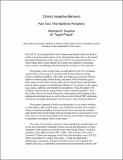| dc.contributor.author | Swaine, Michael D. | |
| dc.contributor.author | Fravel, M. Taylor | |
| dc.date.accessioned | 2012-06-28T18:47:38Z | |
| dc.date.available | 2012-06-28T18:47:38Z | |
| dc.date.issued | 2011-09 | |
| dc.identifier.issn | 1542-4197 | |
| dc.identifier.issn | 1542-4200 | |
| dc.identifier.uri | http://hdl.handle.net/1721.1/71259 | |
| dc.description.abstract | In CLM 32, we examined how both Chinese and outside observers look at
China’s growing assertiveness on the international stage, that is, the purely
perceptual dimensions of the issue. In CLM 34, we assessed whether, to
what extent, and in what manner the Chinese government is becoming
more assertive in defining and promoting the concept of “core interests.” | en_US |
| dc.language.iso | en_US | |
| dc.publisher | Hoover Institution | en_US |
| dc.relation.isversionof | http://www.hoover.org/publications/china-leadership-monitor/article/93591 | en_US |
| dc.rights | Creative Commons Attribution-Noncommercial-Share Alike 3.0 | en_US |
| dc.rights.uri | http://creativecommons.org/licenses/by-nc-sa/3.0/ | en_US |
| dc.source | MIT web domain | en_US |
| dc.title | China’s Assertive Behavior – Part Two: The Maritime Periphery | en_US |
| dc.type | Article | en_US |
| dc.identifier.citation | Swaine, Michael D. and M. Taylor Fravel. "China’s Assertive Behavior—Part Two: The Maritime Periphery." China Leadership Monitor 35 (2011) p.1-29. | en_US |
| dc.contributor.department | Massachusetts Institute of Technology. Department of Political Science | en_US |
| dc.contributor.approver | Fravel, M. Taylor | |
| dc.contributor.mitauthor | Fravel, M. Taylor | |
| dc.relation.journal | China Leadership Monitor | en_US |
| dc.eprint.version | Author's final manuscript | en_US |
| dc.type.uri | http://purl.org/eprint/type/JournalArticle | en_US |
| dspace.orderedauthors | Swaine, Michael D.; Fravel, M. Taylor | en_US |
| dc.identifier.orcid | https://orcid.org/0000-0002-5831-8949 | |
| mit.license | OPEN_ACCESS_POLICY | en_US |
| mit.metadata.status | Complete | |
